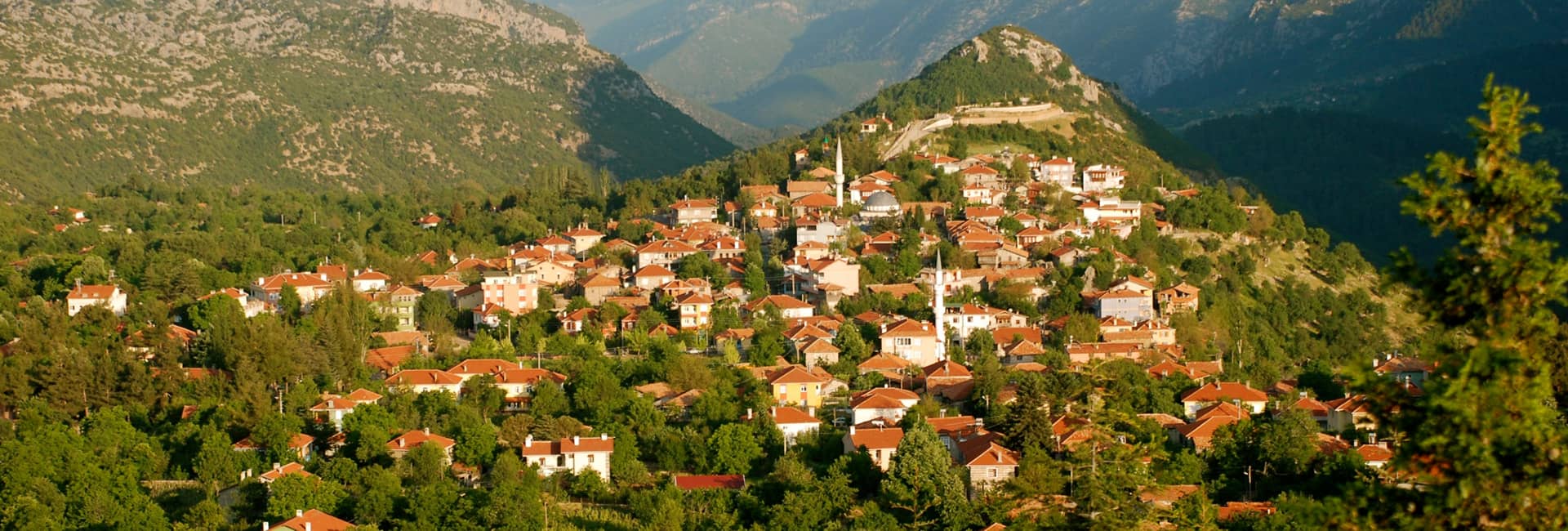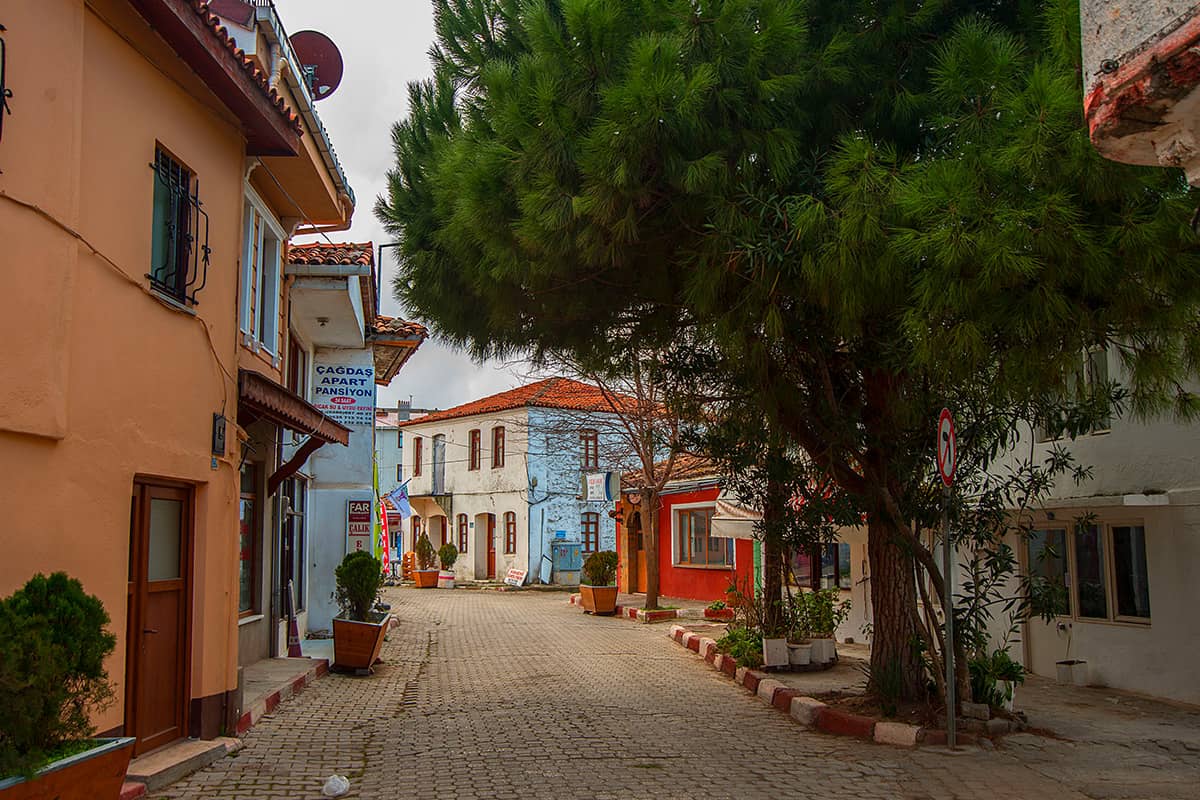

Top 12 Sustainable Trips in Türkiye
If you are a traveller looking to reduce your carbon footprint by exploring less industrialized and invasive terrain, Türkiye is the destination for you with its surprising ecological and cultural diversity. Here is a selection of green adventures and sustainable experiences that will introduce you to the country’s unblemished nature reserves, towering mountains, and pristine beaches & lakes with minimal impact on mother earth. With magnificent heritage sites, diverse flora and fauna, and welcoming local cultures, your epic and picturesque adventure await.
1. Türkiye: An Aerial Crossroads
Throughout history, Türkiye has not only been a conduit for cultures and ideas but also for the migratory birds for whom the country’s skies serve as a flyway for their seasonal journey between Africa and Europe. Two of the most important global bird migration routes pass over Türkiye, through which a variety of fowl relocates to their breeding grounds in the northern hemisphere each spring to escape the southern heat, reversing the journey each autumn. Türkiye’s great variety of mountains, forests, coasts, and wetlands offer a bountiful of transitory home for more than 450 bird species.
Hatay acts as a migration gateway to the peninsula of Anatolia and the mainland of Türkiye, while the Bosphorus and Çanakkale straits provide a convenient corridor for birds en route to Europe. Every spring and autumn, the sky of İstanbul fills with hundreds of thousands of storks, hawks, and eagles -granting an unrivalled viewing opportunity for bird watchers from around the world. Prime vantage points in İstanbul include the Sarıyer and Çamlıca hills.
Indeed many bird sanctuaries can be found around the country, including the Gediz and Büyük Menderes deltas near İzmir. The pristine lakes of Manyas, Uluabat, and Bafa, host waterfowl like flamingos, herons, and pelicans annually. Artvin and Iğdır (Kars) also provide important ecosystems for those bird species who instead migrate to the Caucasia each year.
Travel tip: The best months to observe the great annual migration over Turkish skies are March-May in the spring and August-October in the summer/autumn.
2. The Mythological Land of Olive Trees
On the North Aegean coast of Türkiye, overlooking the Gulf of Edremit, lies the storied mountain range of Kazdağı (Mount Ida) with its soaring peaks, healing springs, and rustic villages. This picturesque locale is not only a popular current destination for seaside holidays and yoga retreats but also a place rich in Türkiye’s agricultural history.
The majority of Türkiye’s olive groves can be found here, making the nation the second-largest olive oil producer in the world. Some of the olive trees in the region are hundreds of years old, providing a direct link to the country’s long history of producing this age-old staple. Adatepe and Ayvalık are home to small local olive producers, as well as museums and tasting centres converted from centuries-old olive oil workshops and factories.
For outdoor enthusiasts, tours of Kazdağı National Park feature valleys, canyons, streams, and waterfalls all connected with majestic trails (and including English-speaking guides on request). Among the 800 plant species known to the region, 78 are endemic, making the area one of Europe’s leading botanic reserves. The area also offers several day trip options, including Gökçeada -Türkiye’s first cittaslow island- as well as several ancient cities, including Troy, Assos, and Antandros.
Travel tip: As recounted by Homer in the Illiad and the Odyssey, Kazdağı (Mount Ida) played a central role as mythological host to the world’s first beauty contest that, as legend has it, triggered the Trojan War back in the 12th century BC. To feel the epic history of the region, see the archaeological site of Troy and its adjoining and exalted Museum of Troy.
3. Country Living in the TurkAegean
The North Aegean Turkish coast hosts several idyllic peninsulas, each encapsulating the joys of country living in Türkiye. Çeşme Peninsula near İzmir boasts many historical, natural, and culinary marvels. The rustic olive oil workshop unearthed in the Ionian city of Klazomenai, near the picturesque seaside town of Urla, proves that the modern olive oil-producing techniques were first developed here some 2600 years ago.
The peninsula is also famous for its hurma olives that undergo a natural fungi-induced “debittering” process on the tree, which makes the olives edible without any further processing. In addition to olives, the region has several other renowned food staples and events. Urla is famous for its gum artichokes, while the city of Çeşme attracts visitors to its annual spring-time Alaçatı Ot Festivali (Herb Festival). Here, over 125 kinds of wild, locally grown edibles -like wild asparagus or blessed thistle are showcased in regional appetizers and delicacies. Seferihisar, the first cittaslow of Türkiye, is famous for its mandarins, consumed fresh or dried.
Figs and grapes are grown to perfection in the TurkAegean as well. These local grapes yield pekmez (grape molasses) and wine -two vital products to the area. The ancient city of Teos is famous for the Temple of Dionysus, an exquisite marble monument dedicated to the god of wine. So, it comes as no surprise that the whole region is among the centres of Turkish viticulture today.
Along the Urla Wine Route, you can visit a series of local wineries, big and small, where some innovative owners are even using sustainable production techniques like gravity flow, allowing the wine to be moved around much more gently. Urla wineries have been carrying on the local winemaking tradition, mainly with international varieties like Cabernet Sauvignon, Merlot, Shiraz, Chardonnay, Sauvignon Blanc, Sangiovese, and Nero d’Avola. Ancient Anatolian grapes on the brink of extinction, like Bornova Misketi (Muscat), Urla Karası, Foça Karası, and Gaydura, have also been reintroduced to the local vineyards in recent decades.
Travel tip: İzmir is part of the EuroVelo Route 8, a long-distance biking trail stretching from the Atlantic shores of Spain all the way to İzmir, with several points of interest, including the ancient UNESCO-protected cities of Pergamum and Ephesus. Alternatively, you can enjoy windsurfing in Alaçatı or observe Mediterranean monk seals near the picturesque seaside town of Foça
4. Paragliding from the Mountain to the Sea
The scenic sandbank and lagoon of Ölüdeniz lie at the foot of the majestic Mount Babadağ, which soars some 1969 meters above the seaside in Fethiye. Due to the rugged geography of the surrounding area, this pristine bay was only recently discovered in the 60s by a group of adventuresome travellers.
The cove later developed into a beachfront resort area with the arrival of the first hotels in the 90s. Ölüdeniz lagoon operates as a national park today, with paragliding from Babadağ offering a hovering front-row seat to its breathtaking panoramas.
Annually, the International Ölüdeniz Air Games hosts competitive international pilots and their fans for a variety of activities, including hot air ballooning, paragliding, microlight flying, skydiving, and base jumping. If you’re not a fan of flying, you can visit the Babadağ summit by cable car year-round to behold one of the best sunsets imaginable.
Travel tip: Usually shortlisted among the most beautiful long-distance treks in the world, Lycian Way offers a 540-km waymarked trail (rated moderate to difficult), starting from Ölüdeniz and ending at Antalya. One can hike the entire trail in a month, or enjoy shorter, multi-day segments of the whole route. The Butterfly and Kabak Valleys are two neighbouring natural wonders that display a rich variety of endemic plants and wildlife, including a colourful butterfly colony. Here you can indulge in ecological retreats featuring beach huts and glamping domes.
5. Learning About the Lifecycle of Sea Turtles
Endangered loggerheads (Caretta caretta) and green sea turtles choose the beaches along the Turkish Riviera as their prime nesting spots, and of these, İztuzu Beach is the most notable. This strip of golden sand along the southwest coast of Türkiye lies at the mouth of the Dalyan Stream, the winding runoff connecting Köyceğiz Lake to the Mediterranean.
This fertile land was home to the ancient civilisation of Kaunos until the 4th century BC, a strategic and prosperous port city invaluable to the merchant ships travelling between the Aegean and Eastern Mediterranean coasts. Today, visitors venture to Dalyan to see the gorgeous temple-like tombs of Kaunos cut into cliff walls. Others come to witness and even volunteer for the conservation projects conducted on İztuzu Beach.
Although sea turtles live for about 100 years, it is estimated that only one out of 1,000 hatchlings survives to be an adult. These sustainability efforts are crucial for the survival of the species in the face of modern development.
Travel tip: Sea turtle nesting activities are regularly monitored by NGOs and universities. It is estimated that about 1500-2500 Caretta Carettas and 700-1000 green turtles nest along the beaches of Türkiye every year. From May to August, you can also observe the females laying eggs and the baby turtles hatching two months later along the beaches of Fethiye, Patara, Çıralı, Belek, and Anamur beaches, as well as Göksu Delta.
6. Taurus Mountains: A Haven for Botanic Enthusiasts
The Anatolia peninsula is one of the more lush and bountiful habitats on earth, enjoying great biodiversity. This is mainly due to its relative warmth during the last Ice Age, which allowed an abundance of plant species to flourish.
As the only country on earth which has three biodiversity zones, Türkiye displays the characteristics of a continent rather than a country, supporting some 12,000 distinct plant species. Indeed 30% of these plants are endemic to this region alone. One-fifth of these distinct plant categories are found in the Mediterranean region of Türkiye, along the Taurus Mountains overlooking the cities of Antalya, Mersin, and Adana.
These mountains dramatically soar above the azure Mediterranean, hosting flowers and vegetation like snowdrops, crocuses, wild orchids, tulips, hyacinths, narcissi, lilies, and cyclamen, as well as the stately cedar forests.
Travel Tip: If you choose Antalya as your base for a Mediterranean botanical tour, you can enjoy the serenity of nature in the context of history. Be sure to include stops in the ancient cities of Phaselis, Olympus, Limyra, Myra, and Termessos, where you’ll find wildflowers among the fascinating ruins. The slopes of the Tahtalı, Alaca, and Güllük Mountains, as well as the Kaş Plateau, are among the best spots for botanic explorers as well.
7. Climbing to the Highest Peaks of Türkiye
Türkiye offers awe-inspiring mountaineering adventures with more than 60 peaks rising some 3,000 metres and stretching throughout its rugged countryside. Ağrı Mountain (Mount Ararat), the highest peak in Europe at 5,137 metres, is the nirvana of Turkish mountaineering for experienced climbers.
The volcanic peak sitting near the northeastern border of the country lures climbing addicts from around the globe with its majestic conical silhouette and mythical history. According to biblical scholars, Noah’s Ark likely landed on a peak somewhere in Türkiye, and many suspect Ağrı Mountain as its final resting place. Today, one can ascend the summit with guided three to seven-day expeditions.
For amateurs, on the other hand, the Kaçkar Mountains in the Black Sea region offer an easier trek and more cultural variety. At the range’s base, one can find lush valleys and high plateaus dotted with quaint mountain villages and remnants of the fabled Silk Road. The mountain’s three peaks can be reached with 3-4 day expeditions of varying difficulties.
Travel Tip: Visiting İshakpaşa Palace is a must for Ağrı Mountain climbers. Just 5 kilometres east of the Doğubeyazıt district, the Palace is one of the most magnificent examples of 18th-century Ottoman architecture. If choosing to visit the Kaçkar Mountains, be sure to explore the picturesque tea plantations of Rize, taste the Karakovan black bee honey of Çamlıhemşin valleys, and indulge in the healing hot springs of Ayder mountain village.
8. Diving in the Turkish Riviera
Türkiye is a magnet for experienced divers with its vast coastline stretching 8,000 thousand kilometres. The southern summer resort of Kaş in the province of Antalya is the country’s leading scuba diving hotspot, both for recreational divers as well as marine biologists, thanks to its rich underwater diversity.
The region offers around 40 diving backdrops ranging from islands and banks to reefs, sinkholes, underwater structures, and expansive canyons. The aquatic life here is vibrant and colourful, with frequently spotted species, including sea turtles, barracudas, stingrays, groupers, morays, and more. There are several caves under protection as the last shelters of the Mediterranean monk seals as well.
Roughly 20 diving schools are available to guide your diving adventures here, organizing expeditions that would suit your level of expertise. New divers can observe several amphoras scattered around the sea bed and later patrol the famed Archeopark featuring a sunken replica of the 3,300-year-old Uluburun shipwreck, displayed in Bodrum Castle today. The venue hosts a variety of battle artefacts as well, including a World War II Italian bomber and a C-47 military cargo plane donated by the Turkish Air Force.
Travel tip: The best time to visit is from June to September when the water temperature is above 21°C and the underwater visibility is crystal-clear. Kekova Island and Patara Beach, with their remnants of ancient Lycian cities, are among the highlights.
9. Exploring a 350-Year-Old Architectural Marvel in Antalya
Düğme (Button) Houses of Antalya might be some of the most sustainable examples of vernacular architecture one would find in Türkiye. The best-preserved ones of these extraordinary stone houses are to be found in Ormana Village, located in the high plateaus of the Taurus Mountains, 165 kilometres from the Antalya city centre.
Made of a framework of timber beams, filled in with small pieces of stones, and then locked with planks made of cedar without any use of mortar, the houses have superior qualities like resistance to earthquake, as stones can move flexibly during the earth’s movements. Also, being energy-efficient with their thick walls, button houses stay naturally warm in the winter and cool during the summer.
Travel tip: Today, some of the button houses in Ormana Village have been converted into traditional hotels that could host you in an atmosphere of homely comfort.
10. A Turkish Lake Holding Clues to Life on Mars
Travelling to Mars may be a fantasy for the distant future, but you can instead consider visiting Lake Salda in Türkiye today -the closest thing to Mars on Earth. In preparation for its Mars 2020 mission, a NASA delegation joined a team from Istanbul Technical University at Lake Salda to study its shorelines and topography. Indeed there are striking mineralogical and geological similarities between Lake Salda and the Jezero Crater on Mars, the landing site for the Perseverance Rover, and its mineral excavation.
Astonishingly, Lake Salda provides some of the oldest known fossilized records of life on our planet, with its shoreline full of microbial sediments eroded from prehistoric rock formations. Scientists are now searching for similar signs of microbial life at Jezero Crater, suspected to be an ancient lake as well. Visitors can enter this protected natural reserve to relax and swim along the shores of Lake Salda, where the white sands conjure a tropical paradise.
Travel tip: The nearby province of Isparta is famous for its rose farms, providing 65% of the rose oil produced all around the world for the perfume, pharmacy, and food industries. The biggest lavender fields of Türkiye are also nearby, at the Akçaköy village of Burdur province. Arrive in May and June to witness the rose harvest and in July for the lavender harvest. The ancient mountain-top city of Sagalassos is also not to be missed with its magnificent Roman theatre and Antonine Nymphaeum, a monumental fountain with pools. Restored to its former glory, this is perhaps the only ancient fountain where one could still drink fresh water.
11. Horseback Riding in Cappadocia
Known for its morning skies filled with graceful hot air balloons, the stunning UNESCO World Heritage site of Cappadocia near the city of Nevşehir sits within a unique landscape formed by the eruption of three volcanoes: Mounts Erciyes, Hasan, and Melendiz. It's a timeless place where the pace of modern life remains at a distance. The volcanic valleys with powdery white soil and rock formations called “fairy chimneys”, along with the historic churches and the cave hotels cut into the tufa, create an otherworldly feel.
One of the best ways of exploring the natural setting is via horseback riding excursions organized by several local ranches. The Turkoman Akhalteke horses, as well as Arabian horses, have adapted to the arid terrain well and offer sturdy support to visitors during the daily horseback tours and multi-day riding adventures. Here you can leave your vehicles and your worries behind.
Travel tip: The subterranean world of Cappadocia is stunning. Staying in a cave hotel, visiting the underground city of Derinkuyu (once home to as many as 20,000 residents), and admiring the Göreme Open Air Museum with its rock-cut churches (dating back to the 10th century) are some of the marvels that make the region feel frozen in time.
12. A “Hands-On” Experience of History in Ankara
The Anatolian Civilizations Museum, which is the country’s most important institution displaying awe-inspiring relics of indigenous ancient civilizations of Türkiye, has recently initiated a pioneering project with a new hall dedicated entirely to visually impaired visitors.
The replicas of 22 artefacts symbolizing different periods from the museum’s permanent collection have been scanned and modelled by 3D printers before being displayed in special stands supported by explanations in the Braille alphabet and audio descriptions as well.
Thanks to this new setting enhancing the accessibility of the museum, visually impaired visitors will be able to touch and feel the artefacts. This new venture is also in line with the UN’s Sustainable Development Goals to reduce inequalities by embracing every citizen in all realms of social life.
Travel Tip: The museum is located at the foot of Ankara Castle, the first settlement of the country’s capital city. Any visit to this little fortified neighbourhood, as well as the historical inns surrounding it, would be a rewarding one for history buffs and connoisseurs of antiques.






